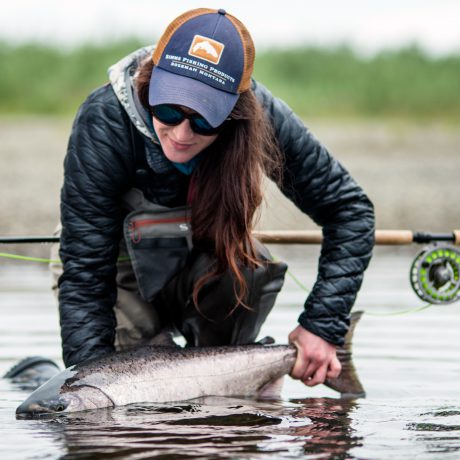
When it comes to fishing for King Salmon on the Kanektok in early June or tanker Rainbow Trout on the Naknek River in the fall, or anywhere where else in Alaska we like using Two-handed rods, otherwise known as Spey rods.
These days, Two-handed or Spey rods and reels are super popular. Despite that, there are a lot of fly anglers who refuse even to try it. They continue to say things like…
- “It’s not traditional fly fishing.”
- “You’re making a bigger deal out of casting than you should.”
- “Spey rods are all about casting far, and you don’t have to cast far to catch fish.”
- “Spey gear is constantly changing and it’s too hard to keep up with.”
- “I don’t fish for steelhead, so why should I care?”
We get it, there is a time and a place for everything, and Two-handed or Spey fishing is not for every river, creek, lake, or fishing situation. Regardless, we like fishing with Spey fishing. Accuse us of being Spey geeks, and you’d be right. We run Spey instruction programs at Alaska West and we’re not shy about the fact that we think Two-Handed or Spey casting is one of the most extraordinary things around.
Here’s why.
- Cover the water with a Two-Hand or Spey rod. If you need to cast more than 20 feet to get your fly into the bucket, you can do it with a Spey rod, with less effort than with a single-handed rod.
- Two haned or Spey rods give better line control. Mending with a longer rod allows you to move more line than mending with a 9′ rod. It just does.
- Two handed or Spey casting is easier on your body – especially your shoulders. There is minimal overall movement compared to a Single Hand rod. WIth a Two-Hand or Spey cast you keep your arms close to your body and still get the line out with full power.
- Casting itself is fun. A lot like acheiving the “ting” when hitting a golf ball with your driver, a good cast with a Two-handed or Spey rod is just as satisflying.
- Sometimes you really do need to cast long. There are times when an 80′ cast just won’t reach the bucket where the fish are holding, and when you need to throw it far, a Two-handed or Spey rod is the best tool for the job.
- It’s not just for Steelhead. Two handed or Spey rods were made for swinging flies, so…any time you need to swing, you should think about a Two-hand or Spey rod. Hoppers for trout on big rivers? Smolt patterns for giant rainbows? Striper fishing when you’ve got current? Yeah, try a Spey rod.
- Fish in more places on the same river. Powerful casts is a happy externality of Two-handed or Spey casting. Orginally developed in the 1800s for The River Spey in Scotland, Two-handed or Spey casting was developed to help avoid rear obstacles located close to the bank. Those wise Scots developed Two-handed or Spey casting to enable you to present a fly in front of you when you’ve got bushes behind you. This happens a lot on rivers located in a lot of rivers in Alaska or the the rest of the USA.
If you have any questions about Two-Handed or Spey fishing, please get in touch with us. We’d be more than willing to answer your questions.
Other Posts about Two-Hand or Spey:
SPEY: It’s all about the casting. Actually catching fish is just a distraction and a nuisance. 😉
I came across a reference to a ‘Shannon Rod’ alongside a reference to Spey Rods in an old British published book on fly fishing. Presumably, it refers to the River Shannon in Ireland, like Spey refers to the River Spey.
I’ve never been able to find anything else regarding it through Google searches.
I’m wondering if there’s any difference between it and Spey rods.